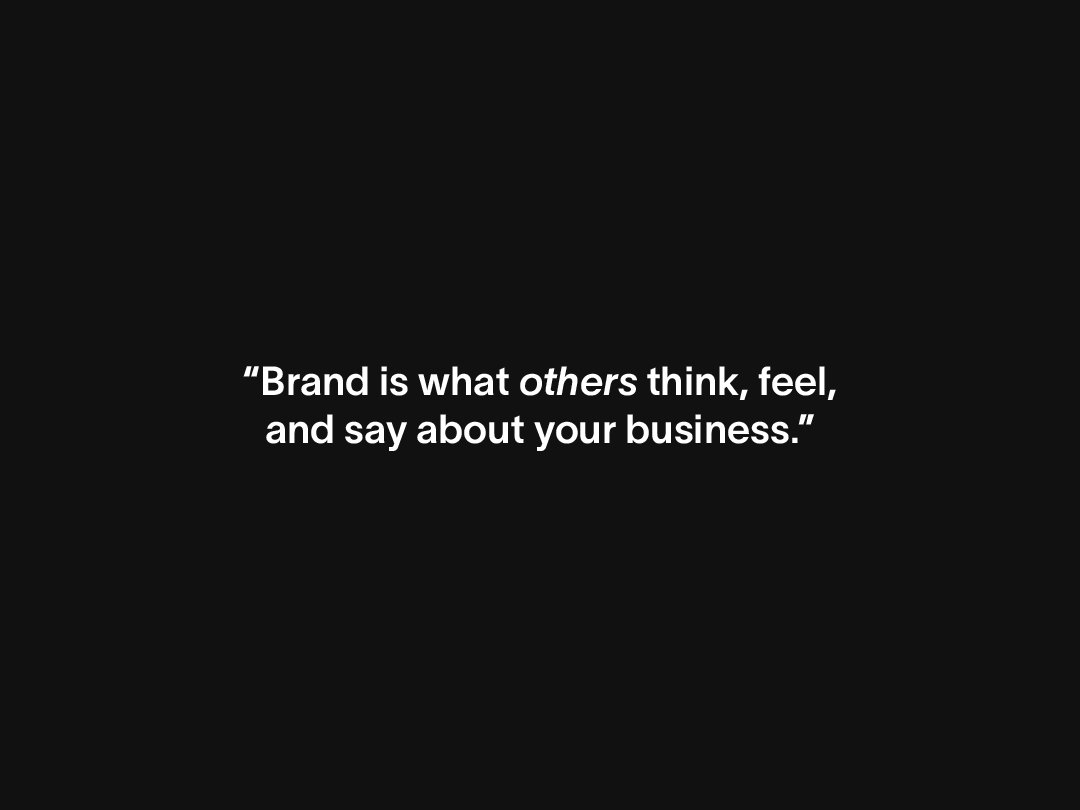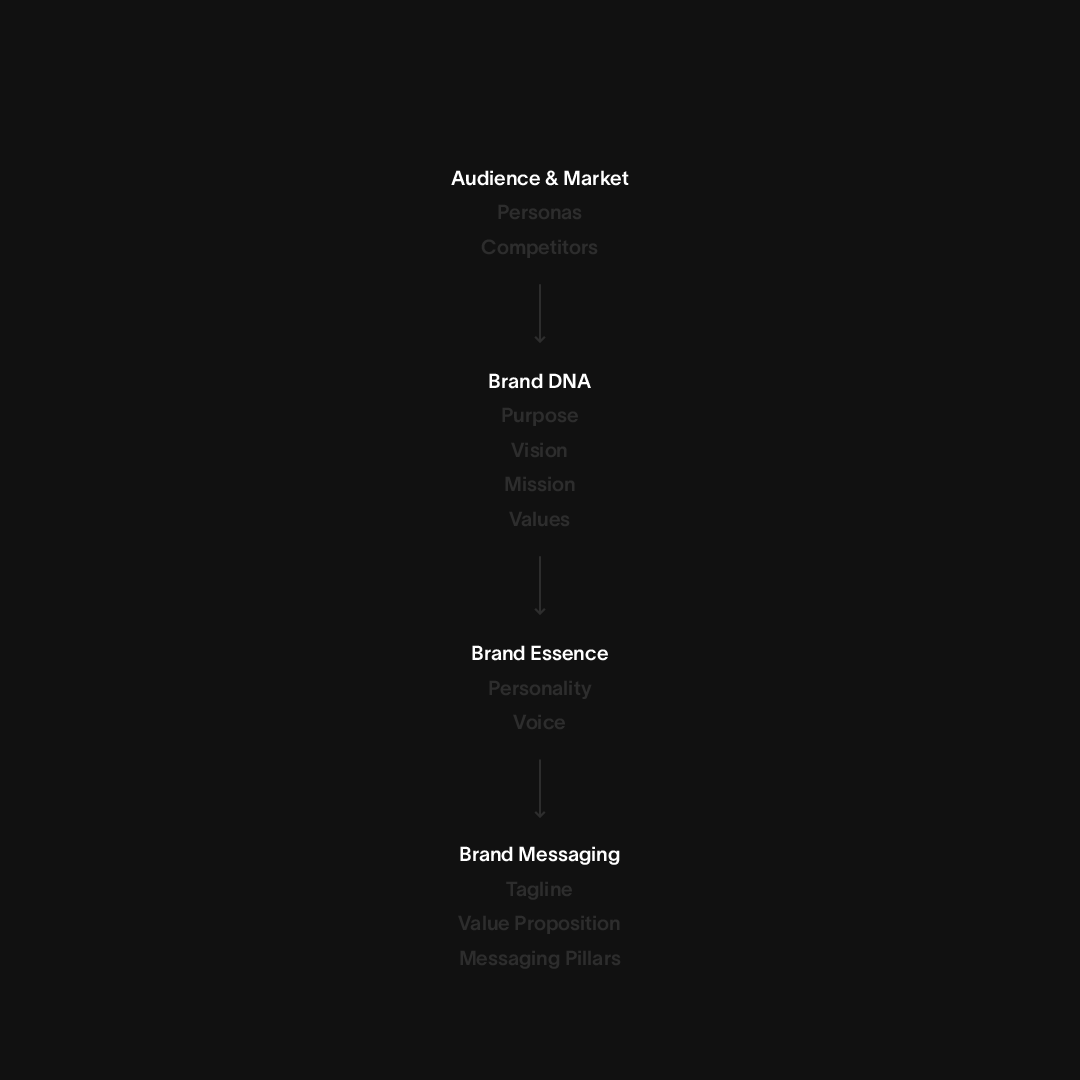How to Create a Brand Strategy (Complete Guide with Free Notion Toolkit)
Building a brand that feels authentic, consistent, and cohesive isn’t just about visuals. it starts with strategy. Without a strong strategy, even the most beautiful branding can feel directionless—everything from your messaging, to your decision-making, to your core business can suffer.
But there’s a reason why this problem is so pervasive: Building a strong brand strategy isn’t easy. It takes time, thought, and a willingness to ask questions about who you are, what you stand for, and where you’re going. We know, because we’ve been there ourselves.
That’s why we created this guide. To simplify the process and make it something any business can actually do. Inside, you’ll find a step-by-step framework (and our free Brand Strategy Lab Notion Template) to help you align your brand from the inside out, strengthen your message, attract the right people, and build a foundation that grows with you.
How We Got Into Brand Strategy
We started doing brand strategy work after repeatedly meeting clients who needed visual identity help but couldn’t clearly articulate who they were or what they actually wanted to achieve beyond beautiful visuals. We soon realised their identity wasn’t the core issue—they needed their whole brand direction to be aligned. We were keen to help, but two things quickly became clear:
- People make brand strategy more complicated than it needs to be. There are so many methods, conflicting opinions, and old-school exercises that just don’t resonate. If we wanted a simple, usable framework our clients could actually use, we’d have to tailor one ourselves.
- We didn’t understand our own brand as well as we thought. Working with other people’s brands exposed the same problems in our own business. Who are we? What do we actually do? Why does it matter? Before we could take our clients through the framework, we needed to test it on ourselves.
So we rolled up our sleeves and did the work. After refining the approach (first with our own business, then with a few early clients) we landed on a brand strategy process that’s straightforward, practical, and flexible enough for any size of business. It wasn’t easy, but it was worth it.
We believe it’ll be worth it for you, too. This guide condenses everything we’ve learned into a step-by-step process that helps you to:
- Understand who you really are and use your beliefs and values to design a brand (and business) that supports the life you want to live.
- Communicate consistently and clearly across all your brand touchpoints—building trust, credibility, and recognition over time.
- Attract the right customers by connecting with like-minded people on a human level through shared values and beliefs.
- Position your brand by identifying what makes you different, why it matters, and why customers should choose you.
- Make better decisions—use your strategy as a guide that points you in the right direction.
To make it easy, we’ve included the templates, questionnaires, and real-life examples in a free Notion template to help you apply each step. You’ll want to start by duplicating our free template: The Brand Strategy Lab.
As you work through, follow the steps in order—as each one builds on the last—and you’ll finish with a brand strategy that’s ready to grow as your brand does.
What Is a Brand?
Generally, when people think of “brand,” they’re thinking of the physical mark (or visual elements) that identify the business that produced it. But a brand is more than a physical mark. It’s an emotional mark—more importantly, an emotional experience, strengthened or weakened through every touchpoint with that business.
We believe brand is what others think, feel, and say about your business. (This is the opposite of marketing. Marketing is what you say about your business.)

What Is a Brand Strategy?
A brand strategy is a guide to help a business present itself authentically, originally, and consistently. Our brand strategy process is broken into four distinct parts:
- Audience and Market: Your audience and competitive landscape.
- Brand DNA: Your brands foundation (purpose, vision, mission, and values).
- Brand Essence: How you want people to feel when they experience your brand.
- Brand Messaging: The way you talk about your brand.

With a solid brand strategy, you can make sure your brand is aligned to your core beliefs, nurture an emotional connection with the people you’re trying to reach, and increase the chances that those people will think, feel, and talk about you the way you want them to.
Why a Brand Strategy Matters
If you don’t know who you are, why you exist, what you believe in, or what you’re trying to achieve, both you and your business suffer. From inconsistent messaging to misaligned teams, the absence of a brand strategy creates challenges across your entire business.
After working with many clients over the years, we’ve learned to recognise the signs of a brand struggling—often caused by a lack of strategy. If any of these sound familiar, it could be a sign your brand needs some help (our own business suffered from them before we built our strategy framework):
- Inefficient decision-making: You lack clarity on your beliefs and values, so you make decisions that don’t align with them.
- Inconsistent messaging: Your messaging feels inconsistent, confusing, or even contradictory—making it hard to attract like-minded people, whether customers or employees.
- Poor customer connection: You don’t understand who you’re for and why you exist, your audience struggles to relate to your brand, making marketing less effective.
- Difficulty standing out: You struggle to articulate your brand clearly, making it hard to claim a recognisable position in the market.
- Low internal alignment and morale: Your team isn’t sure how to represent the brand, which makes it harder for them to stay engaged and motivated.
When you define who you are, what you believe in, and what you’re trying to achieve, everything else becomes easier. Your marketing works better, your team acts with clarity, and your brand starts working for you—not against you.
How to Create Your Brand Strategy
Having helped brands of all shapes and sizes create their brand strategy, we’ve come up with a simple step-by-step process to run you through. By the end, you’ll have brand strategy that’s ready to grow as your brand does.
A few more things to consider throughout this process:
- Take on one element at a time. Brand strategy can feel overwhelming if you try to tackle everything at once. Focus on each part individually—audience, Brand DNA, essence, and messaging—so you can give it the attention it deserves. Each step builds on the last, and completing them in order makes the process manageable and ensures your final strategy is cohesive and actionable.
- Allocate enough time. The amount of time varies depending on the size of your business, how many stakeholders are required, etc. A smaller business might take several weeks, whereas a larger business might take several months to work through these elements.
Most importantly, remember: This is deep work, so only take it on when everyone can devote the time.
Part 1: Audience and Market
1) Identify Who You’re For
Who are you trying to reach? What do they need or want? Where are their needs not being met?
A strong brand strategy starts with understanding your audience. Marketing personas give you a clear picture of who your ideal customers are, what they care about, and how to connect with them. With this insight, you can create content, messaging, and experiences that actually resonate—and avoid guessing what your audience wants.
How to do it: Use the Marketing Personas Template in the Brand Strategy Lab and follow our full Guide to Creating Marketing Personas to identify your audience’s goals, pain-points, and preferences, and turn those insights into content and messaging that truly resonates.
2) Identify Who You’re Against
Who are your competitors? How do they position themselves? Where can you stand out?
Understanding your competition is a crucial part of building a strong brand. A competitive analysis helps you see how others operate, spot gaps in the market, and define a unique position for your brand. By knowing who you’re up against, you can make strategic choices that set you apart while staying true to your values.
How to do it: Use the Competitive Analysis Template in the Brand Strategy Lab and follow our full Guide to Complete Your Competitive Analysis to identify your competitors, evaluate their strengths and weaknesses, and uncover opportunities to position your brand for success.
Once you’ve identified your audience and competition, you’re ready to start shaping your overall brand strategy.
Part 2: Find Your Brand DNA
Every brand has a fundamental set of beliefs that shape everything they do—from how they present themselves, to how they communicate, to how they make decisions. We call this your Brand DNA.
Your Brand DNA captures the essence of who you are and why you exist. It guides your behaviour, builds trust with your audience, and keeps your brand consistent and authentic. When it’s strong, it unites your team, clarifies your direction, and helps you make better decisions. When it’s weak, your brand can feel inconsistent, your team and customers can become disconnected, and you can easily make decisions that derail your long-term goals.
Your Brand DNA is made up of four key elements:
- Purpose: Why do you exist?
- Vision: What future do you want to create? What does the future look like?
- Mission: What are you here to do? How do you create that future?
- Values: What principles guide your behaviour?

How to do it: Use the Brand DNA Template in the Brand Strategy Lab and follow our full Guide to Finding Your Brand DNA for a step-by-step process to articulate these four elements and align your brand from the inside out.
Pro Tip: Even though your Brand DNA is often for internal use, it can be used for external messaging too (e.g., your website, social profiles, product packaging), which is why getting it right early makes everything else easier.
Part 3: Create Your Brand Essence
Now that you’ve defined your Brand DNA, you have a clear understanding of who you are. The next step is to uncover your Brand Essence (how you express who you are) and your Brand Messaging (how you communicate who you are). When these elements are clearly defined, your brand can communicate with honesty, authenticity, and consistency across every touchpoint.
First up, let’s focus on your essence. Your Brand Essence consists of your personality and tone of voice. These are the elements that shape how your brand expresses itself. Defining them isn’t about inventing something new. It’s about uncovering what’s already there. Your essence already exists; you just need to bring it to the surface and document it clearly.
1) Identify Your Brand Personality
Your brand personality is essentially your brand’s human characteristics and traits. Are you premium and luxurious? Rebellious and edgy? Helpful and approachable? Your personality is a reflection of your Brand DNA—your purpose, vision, mission, and values—and helps bring your brand to life in everything you do.
When you’re clear on your personality, you can infuse it into every touchpoint, from your website copy to your social profiles, and customer interactions. This clarity not only differentiates your brand, but also builds trust and strengthens connections with your audience.
How to do it: Use the Brand Personality Template in the Brand Strategy Lab and follow our full Guide to Finding Your Brand Personality to identify your traits, define what your brand is (and isn’t) and make your personality felt across everything you do.
2) Identify Your Brand Voice
Your brand voice is how your brand’s personality comes to life through words. It shapes how people perceive you, helps you stand out, and builds trust with your audience. A clear voice ensures consistency across every touchpoint, from website copy to social posts, and reflects both your Brand DNA and Brand Personality. The more intentional you are, the easier it is to communicate authentically and connect with the people you want to reach.
How to do it: Use the Brand Voice Questionnaire in the Brand Strategy Lab and follow our Guide to Finding Your Brand Voice to define how your brand should sound, the language to avoid, and ways to consistently express your personality across all channels.
Part 4: Create Your Brand Messaging
Your brand messaging is how your brand tells its story. It’s the language, tone, and key messages you use to communicate who you are, what you do, and why people should choose you. Clear, consistent messaging builds trust, strengthens connection, and helps you stand out, while weak or vague messaging can leave your audience confused and disengaged.
While every business may approach messaging differently, we use a clear framework built around three key elements:
- Tagline: A short phrase that communicates your brand promise, personality, and positioning.
- Value Proposition: A clear explanation of the functional and emotional benefits your product or service provides to your customer.
- Messaging Pillars: 3-5 stories you tell to underpin your value proposition and tagline (aka your main selling points).

Together, they create a cohesive narrative your audience can recognise, trust, and engage with.
1) Write Your Value Proposition
Even though your brand messaging framework ultimately builds from your messaging pillars up to your tagline, we recommend starting with your value proposition. Why? Because it captures the essence of who you are and what you do.
Your value proposition is the clearest, simplest way to explain why someone should choose your brand. It communicates both the functional and emotional benefits your product or service delivers, and acts as the foundation of your brand messaging framework. While your tagline captures the big idea, your value proposition supports it, explaining what you do, how you help, and why it matters.
How to do it: Use the Brand Messaging Template in the Brand Strategy Lab and follow our full Guide to Writing a Value Proposition to clarify what makes your brand unique, communicate the benefits you deliver, and craft a message that resonates with your audience and drives action.
2) Write Your Tagline
A tagline is a short phrase that captures your brand’s essence, personality, and positioning. Unlike a slogan, which promotes a specific product, a tagline represents your brand as a whole. It’s often the first thing people remember, and a strong one builds connection, communicates value, and differentiates you from competitors.
How to do it: Use the Brand Messaging Template in the Brand Strategy Lab and follow our full Guide to Writing a Memorable Tagline to create a tagline that connects with your audience and reinforces your brand story.
3) Identify Your Messaging Pillars
Messaging pillars are the core themes or selling points that support your value proposition and tagline. Think of them as 3–5 key benefits that explain what makes your brand unique, why people should care, and how you deliver on your promise.
A strong set of messaging pillars does three things:
- Clarifies your strengths: They highlight what sets you apart from the competition.
- Connects emotionally: They show the benefits your brand delivers, both functional and emotional.
- Guides your communication: They provide consistent language and ideas which you can weave into all your content.
Once defined, your messaging pillars become the foundation for all your marketing and communications. They guide copywriting, inspire content, and ensure your brand story is consistently told across every touchpoint.
How to do it: Use the Brand Messaging Template in the Brand Strategy Lab and follow our full Guide to Create Your Brand Messaging to identify 3–5 core themes or selling points that capture what makes your brand unique.
Pro Tip: Your value proposition, tagline, and messaging pillars form the core foundation of your brand messaging. Depending on your brand’s needs, you may also choose to articulate additional elements like your brand story, origin/founder story, or key product narratives to add depth, context, and connection.
Part 5: Create Your Brand Strategy Guidelines
Now that you’ve defined your audience, Brand DNA, essence, and messaging, the final step is to pull everything together into a set of Brand Strategy Guidelines. Think of this as your brand’s playbook. A reference that keeps you (and your team) aligned, your messaging consistent, and your brand working as it should.
Traditionally, brand guidelines include direction for both your verbal and visual identity. However for the purpose of this guide we’ll be building out guidelines for your verbal identity only.
Your guidelines don’t need to be long or complicated. They just need to clearly outline the core elements of your brand and show how they should be applied across different touchpoints. At a minimum, your Brand Strategy Guidelines should include:
- Brand DNA: A summary of who you are (your purpose, mission, vision, and values).
- Personas: Key details about your target audience and what matters to them.
- Brand Essence: How your brand expresses itself, including tone of voice, and personality traits.
- Brand Messaging: Your tagline, value proposition, and messaging pillars (plus any additional stories or narratives you want your brand to consistently tell).
How to do it: Use the Brand Strategy Lab to compile everything you’ve worked on into a single, actionable document and make it easy to reference for your team, collaborators, or future partners.
Pro Tip: Your guidelines are a living document. As your business grows, update them to reflect new offerings, or changes in your brand positioning. The goal is to ensure your brand stays consistent and aligned with your beliefs, values, and audience over time.
By creating Brand Strategy Guidelines, you turn all the insights, decisions, and frameworks you’ve developed into a practical tool. This ensures everyone who represents your brand knows exactly how to communicate in a way that strengthens your identity and builds trust with your audience.
How to Bring Your Brand Strategy to Life
Your brand strategy is the foundation of your brand. It tells you who you are, who you’re for, and how to communicate consistently. But a strategy alone isn’t enough. To truly bring your brand to life, you need a visual identity that embodies everything you’ve defined in your strategy.
A strong visual identity is more than just a logo. It’s the look and feel of your brand across every touchpoint, including:
- Logo and marks: The symbols and logos that represent your brand.
- Colour palette: A consistent set of colours that reflect your brand personality and resonate with your audience.
- Typography: Fonts that express your brand’s tone, hierarchy, and style.
- Imagery and photography: Visual content that communicates your brand story and values.
- Design elements: Supporting graphics, icons, or textures that make your brand recognisable and cohesive.
The key is that your visual identity should always reflect your strategy. Without a clear strategy, even the most beautiful visuals can feel disconnected, inconsistent, or forgettable. Your strategy ensures that your visual identity communicates your purpose, personality, and positioning in every detail.
This is where we can help. Whether you’ve worked through our brand strategy guide or are just starting to clarify your brand, we can guide you in developing a strategy and bringing it to life visually. We create visual identities that aren’t just beautiful—they’re strategic, consistent, and meaningful. Every element, from colour and typography to imagery and iconography, is informed by your strategy, ensuring your brand looks and feels cohesive across all touchpoints.
If you’re ready to start building a brand that’s not only strategic but also instantly recognisable, hit us up. We’d love to help bring your brand to life.
Once your strategy is reflected visually, it’s time to make it work for your whole business…
How to Use Your Brand Strategy Once You’re Finished
You’ve done the hard work and now have a clear brand strategy in place. The next step is to put it into action—so your brand communicates consistently, builds trust, and nurtures the relationships you need for long-term success. Here’s a few ways to get started:
- Use it to guide everything you do. From website copy and social posts to pitch decks and internal communications, every decision should tie back to your strategy. Your strategy becomes your decision-making guardrail, ensuring everything you do reinforces who you are and what you stand for.
- Bring it to life visually. Use brand colours, typography, imagery, and other elements across all touchpoints. Remember: a strong visual identity is only effective when it reflects your strategy (it’s the strategy that gives your visuals meaning and direction). Find out what it’s like to work with us on your visual identity.
- Embed it in your processes. Use your strategy to inform marketing campaigns, inspire content, guide copywriting, and shape customer interactions (e.g., Messaging pillars can generate content ideas that align with your story. Brand Personality can guide your tone in customer service. Brand DNA can shape business decisions and partnerships).
By using your brand strategy actively, you turn it from a document into a living tool. One that shapes every interaction, every experience, and every impression your brand makes.
And if you get stuck, or want support bringing your brand to life, we can help. Whether it’s refining your strategy, rolling out a visual identity, or ensuring your messaging lands consistently, get in touch with us today.